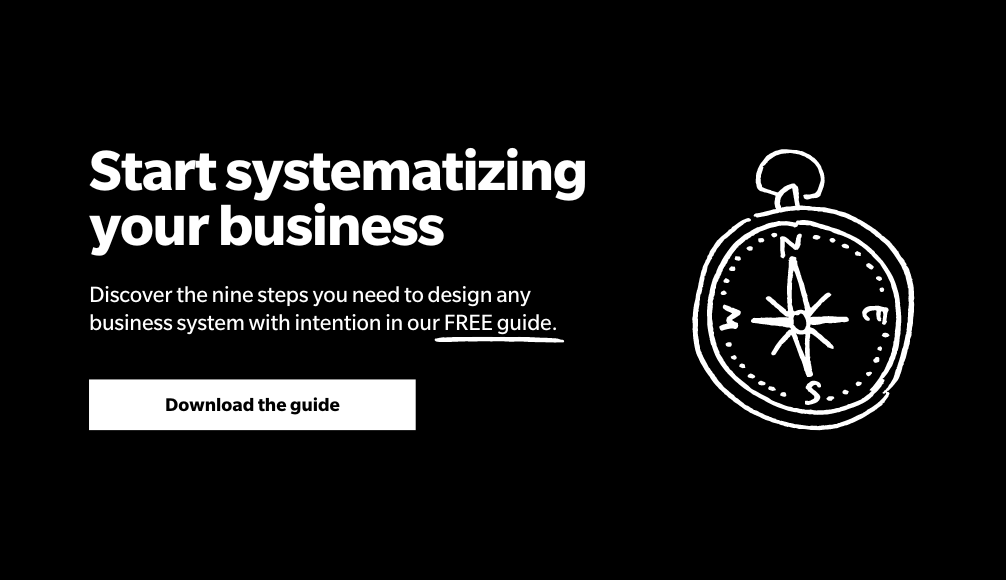If you’re a business owner trying to develop the foundation of your business, you have to balance two perspectives: the reality, challenges and concerns of what exists today, and goals for the year(s) to come. Reality dictates that you’ll be building systems while still working in your existing business. If you’ve built your organization as a manager or technician—and spent significant amounts of time in the business—you can’t abruptly stop working in it and switch over to working on it overnight. Chaos would surely ensue. Having a systems strategy will help you create balance so you can prioritize working on your new business—what your business will look like in the future.
We call this working in “Old Co” while working on “New Co.” It takes a while to think about systems development in this way. But if you start planning now, you’ll save valuable time and avoid misdirected resources in the future.
Develop a strategic perspective
Looking at your business from the outside is probably not something you do often. It can be a difficult perspective to take. Let’s consider an extreme example: a view from space.
"We learned a lot about the Moon, but what we really learned was about the Earth. The fact that just from the distance of the Moon you can put your thumb up and you can hide the Earth behind your thumb. Everything that you've ever known, your loved ones, your business, the problems of the Earth itself—all behind your thumb."
-Jim Lovell, Apollo 8 and 13
Put yourself on the Apollo rocket, looking back at planet Earth. Imagine the blue oceans, continental shapes, emerald greens, ochre, gold, swirling clouds and the infinite dark of the universe beyond.
Now imagine your business five years from now from the same extraterrestrial perspective. Can you see the entire ecosystem that is your business? Imagine you can zoom in and see the inner workings—your employees, your suppliers, your customers, your neighbors. What does it look like? How does it feel?
As Einstein said, “No problem can be solved from the same level of consciousness that created it.” You must shift your perspective from working in your business to working on your business as a strategic thinker. You’ll need to look at the bigger, more distant picture—much like an astronaut sees Earth from a different place than the rest of us.
Build strategic instead of reactive systems
Most businesses already use systems—some consciously, and some simply out of habit. But their systems are typically reactive. They’re meant to quickly solve a frustrating problem or put a band-aid on a difficult situation. Imagine: a symptom presents itself in your business, prompting you and your team to reactively create a system solution, which you implement without testing, quantification or training. It’s a common way of running an unsystematized business.
Here’s an example:
A delivery arrives and the driver asks your receptionist to pay in cash before they’ll leave the goods. In the resulting chaos of trying to find cash, the receptionist leaves their desk and misses a vital customer order. Your gut reaction is to buy a petty cash tin so that in the future the receptionist can pay the delivery guy quickly and get on with the more important priority of taking orders. You make a mental note to put “handling cash” on the to-do list of systems to be built. These are the types of things necessary to keep your current business moving.
Looking at that example from a strategic lens, you may instead realize that your management systems need improving. Your hiring process didn’t require or test your receptionist’s ability or willingness to handle cash. Your sales process needs improvement if one missed phone call means losing new business. And the fact that one of your suppliers removed your credit terms and insisted on cash on delivery indicates you're lacking some essential finance systems.
Working on current problems from a strategic perspective is an opportunity to infuse new systems strategy into your existing business. It doesn’t take more time to do this—it’ll always take time to solve day-to-day problems in your business. But it does take a different perspective. You’re still solving problems that need solving, but you’re seeing them as strategic opportunities rather than tactical headaches.
Use a model for strategic system design
Your business is an ecosystem, just like our planet. And just as Earth is the aggregate of its systems—air, water, land and life—your business is an aggregate of seven essential systems.
Leadership is all about learning to recognize the unique qualities your business needs from you as a leader and defining values and a brand promise that will shape every choice you make as a business owner. As the leader of your business, you need to prioritize thinking systemically and building effective systems.
Do you know how to lead others to do the work of your business the way you’d do it yourself?
Do you have a clear picture of where you'd like your company to be in five years?
Do you track whether or not you're on target to achieve your vision?
Marketing allows you to understand your markets and your customers so well that you know what they value and can anticipate how they make purchase decisions. This understanding informs the way you communicate with the world.
What's the one thing you want every single customer to say about your company?
Finance is about controlling the movement of money through your business, leveraging it as a tool to achieve your business vision and creating your company’s financial value.
Do you use your financial reporting to make strategic and day-to-day decisions about your business?
Do you have key financial indicators that you regularly review to understand the health of your company and progress toward your goals?
Management is the way you manage people and other resources within your business in order to get results through the work of others as individuals and as a team.
Do your people understand what you want from them, and do they work independently and as a team to achieve the business results you want?
Do you have a written organizational chart where accountabilities are clearly defined and where you've delegated each part of the business to a manager?
Customer Fulfillment includes producing and delivering your products and services, as well as customer support services.
What part of your customer experience makes you most proud?
What are your most common compliments and complaints?
Lead Conversion includes selling your products or enrolling customers in your services. It’s converting prospects into customers.
Do you have an effective Sales Process that consistently produces the desired results?
Lead Generation includes creating awareness in your target markets and attracting customers to your business or your products.
How do you attract and track leads in your business?
Do you know the cost of acquisition for each new customer?
A business that works needs all seven of these systems. Every essential system touches every other essential system, and no single system can stand alone.
Developing a systems strategy requires you to build the foundational systems that stop the wheels falling off while slowly creating time to work on systems that will move you from your existing business to a new, future state of business shaped in your vision.
If you're ready to start working on systematizing your business, schedule time to talk to an EMyth Coach. Your first session is on us.




Comments